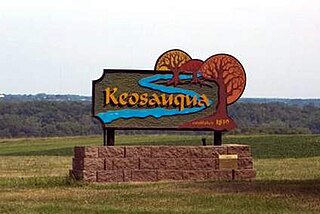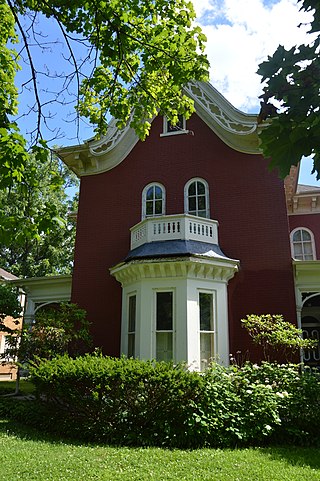
Keosauqua is a city in Van Buren County, Iowa, United States. The population was 936 at the time of the 2020 census. It is the county seat of Van Buren County.

Marietta is a historic house and former tobacco plantation located in Glenn Dale, Prince George's County, Maryland. On the National Register of Historic Places and the National Underground Railroad Network to Freedom, Marietta House Museum includes a federal era house, a cemetery, the original root cellar, and harness room, as well as Judge Gabriel Duvall’s original law office building. The historic site sits on 25 acres of Marietta’s original 690 acres. Today, visitors can walk the grounds and tour the plantation buildings and sites where free and enslaved people lived and labored.

Harriet Tubman National Historical Park is a US historical park in Auburn and Fleming, New York, associated with the life of Harriet Tubman. It comprises three properties: the Harriet Tubman Home for the Aged, in Auburn; the nearby Harriet Tubman Residence ; and the Thompson A.M.E. Zion Church in Auburn. They are located at 180 and 182 South Street, and 90 Franklin Street, respectively. The Zion Church unit is administered by the National Park Service (NPS), while the South Street properties, including a historic barn and a visitor center, are jointly managed and operated by both the NPS and the Harriet Tubman Home, Inc. The church also works with the NPS in park operations. The Harriet Tubman Grave in nearby Fort Hill Cemetery is not part of the park.

The Takoma Park Historic District is a national historic district located at Takoma Park, Montgomery County, Maryland. The district area was platted in 1883 by developer Benjamin Franklin Gilbert, and promoted for its natural environment and healthy setting. Originally an early railroad suburb, the opening of streetcar lines led to the expansion of the district in the early 20th century. Takoma Park houses built between 1883 and 1900 are fanciful, turreted, multi-gabled affairs of Queen Anne architecture with Stick Style and Shingle Style influence. Buildings developed after the turn of the 20th century tend to be 1-2 story brick structures with simple ornamentation, although a few display characteristics of such styles as Art Deco and Tudor Revival.

Troy, also known as Troy Hill Farm, is a historic slave plantation home located at Elkridge, Howard County, Maryland, United States. It is associated with the prominent Dorsey family of Howard County, who also built Dorsey Hall.

The Crescent Warehouse Historic District is a 10.5-acre (4.2 ha) historic district in Downtown Davenport, Iowa, United States. The district is a collection of multi-story brick structures that formerly housed warehouses and factories. Most of the buildings have been converted into loft apartments. The district was listed on the National Register of Historic Places in 2003.

The Cass County Courthouse in Atlantic, Iowa, United States, was built in 1934 as the first courthouse in the state built with funding from the Public Works Administration (PWA). It was listed on the National Register of Historic Places in 2003 as a part of the PWA-Era County Courthouses of Iowa Multiple Properties Submission. The courthouse is the third structure to house court functions and county administration.

The Van Buren County Courthouse located in Keosauqua, Iowa, United States, was built in 1843. It was listed on the National Register of Historic Places in 1977 as a part of the County Courthouses in Iowa Thematic Resource. It is the only building the county has used as its courthouse, and it is the oldest courthouse in Iowa. In 1845 the courthouse served as the location for a trial resulting in the first death penalty in Iowa history.

The Franklin County Courthouse in Hampton, Iowa, United States was built in 1891. It was individually listed on the National Register of Historic Places in 1976 as a part of the County Courthouses in Iowa Thematic Resource. In 2003 it was included as a contributing property in the Hampton Double Square Historic District. The courthouse is the third facility to house court functions and county administration.

The Hardin County Courthouse, located in Eldora, Iowa, United States, was built in 1892. The courthouse is the third building to house court functions and county administration. It was individually listed on the National Register of Historic Places in 1981. In 2010 it was included as a contributing property in the Eldora Downtown Historic District.

The C. R. Joy House, also known as The Grande Anne Bed & Breakfast, was a historic building located in Keokuk, Iowa, United States. It was destroyed by fire in July 2018. It was individually listed on the National Register of Historic Places in 1997. In 2002 it was included as a contributing property in The Park Place-Grand Avenue Residential District.

Old Main is an historic building located on the Iowa Wesleyan University campus in Mount Pleasant, Iowa, United States. Built in 1854, when James Harlan was the college's president, it is the second building constructed on the campus after Pioneer Hall. It is believed that Old Main was the first genuine collegiate building built in Iowa. The bricks for the building were manufactured locally by Benjamin Franklin Pearson of Keosauqua, Iowa, who also was responsible for some of the building's construction. The three-story building has modified classical features. It was designed to have classrooms on the first two floors and the library, natural history museum and chapel on the third floor. The building is capped with a hip roof with bracketed eaves, and a wooden cupola with a low dome painted gold.

Samuel Nichols House is an historic residence located in rural Muscatine County, Iowa, United States near the town of Nichols. It has been listed on the National Register of Historic Places since 1978.

Chief Justice Joseph M. Beck House is a historic building located in Fort Madison, Iowa, United States. It was individually listed on the National Register of Historic Places in 1984. In 2014 it was included as a contributing property in the Park-to-Park Residential Historic District.

The Alfred Hebard House is a historic residence located in Red Oak, Iowa, United States. Hebard settled in Iowa five years after he graduated from Yale in 1832. He farmed outside of Burlington during which time he served in the territorial legislature. In 1853 he did a preliminary survey across southern Iowa for the Burlington and Missouri River Railroad. He and others surveyed and platted the town of Red Oak Junction in 1857, and settled there in 1868 when the railroad was built through the region. Hebard served in the Iowa Senate from 1875 to 1879. He had David S. Haas build this house for him in the summer and autumn of 1874. Hebard and his wife Anna lived in the house until his death in 1886. The house remained in the family until 1925. It was used as the parsonage for the First Congregational Church from then until 1932.

Lacey-Keosauqua State Park is located southwest of Keosauqua, Iowa, United States. The park is located along the Des Moines River in Van Buren County. First dedicated in 1921, it is the largest state park in size in Iowa. In 1990, three areas were named nationally recognized historic districts and listed on the National Register of Historic Places.

The Voltaire Twombley Building is a historic building located in Keosauqua, Iowa, United States. The two-story structure is a good example of 19th-century vernacular commercial design constructed in limestone. it is the largest example of stone construction that remains in Van Buren County. While it was built in the 1870s, it is more reminiscent of similar buildings constructed in the 1840s and 1850s. The only thing that differentiates these rectangular, front gable structures from a house or a school is the first floor storefront. Keosauqua had several stone commercial buildings at one time, but now they are all brick but this one. The building is associated with Voltaire P. Twombly, who was awarded the Medal of Honor for bravery at the Battle of Fort Donelson during the American Civil War. He operated a dry goods and grocery business in this building beginning in 1876. It was listed on the National Register of Historic Places in 1993.

The Shelburne Village Historic District encompasses the central portion of the main village of Shelburne, Vermont. Centered on the junction of United States Route 7 with Harbor and Falls Roads, the district's architecture traces the town's history from the 18th to early 20th century. It was listed on the National Register of Historic Places in 1990.

The Collins-Bond House is a historic house located at 402 South Main Street in Salem, Iowa.






















